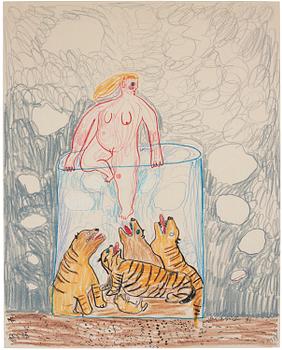Contemporary Art & Design presents Lena Cronqvist
Lena Cronqvist, "Den röda vallmon"
Bukowskis presents the work "Den röda vallmon" by Lena Cronqvist at the upcoming auction Contemporary Art & Design – The Only Dedicated Live Auction in the Nordics For Contemporary Art and Design.
Since her debut in 1965 at Galerie Pierre in Stockholm, Lena Cronqvist has fascinated and moved audiences with her powerful depictions of what it means to be human. Her paintings leave no one untouched. It is from her own experience and the private sphere that Lena Cronqvist draws her inexhaustible source of inspiration. As an artist, she has painted her way through the rollercoaster of life and, through her own experiences, has accessed something deeply human. We encounter our own dreams and fears in her works; we confront memories, hopes, and anxieties. At the same time, Cronqvist takes her place as part of a long artistic tradition, using her own impressions and experiences in dialogue with her artistic predecessors.

In "Den röda vallmon" (The Red Poppy), the couple's relationship and the complicated power dynamics that can unfold in the encounter between man and woman are depicted. A man lies stretched out on a bed, with one eye open, while in front of the bed stands a naked woman, seemingly completely unperturbed. Her pose is proud and rigid, and her expression inscrutable. The entire scene is bathed in a cold, winter-faded milky white light that blurs the outlines. As the only contrast, the petals of the giant poppy that the woman holds in her hand glow blood-red. The symbolism is clear. The poppy has, historically and in our time, been associated with the remembrance of loss, memories, comfort, and hope. Cronqvist invites the viewer to become a spectator to the silent chamber play that unfolds. The artist explores this theme time and again throughout the year of 1984.
In another version of the motif, with the same title, exhibited at the Royal Academy of Fine Arts and depicted in literature, the power balance between the couple has shifted. The man sleeps undisturbed with his hands behind his head. In front of him stands the woman, holding the fragile flower carefully in her hand. Her face is open, and her gaze is pleading and contemplative. A third composition, "Olympus," evokes thoughts of Édouard Manet's scandalous Olympia from 1864. The playing field has once again changed, and the drama is heightened by the fact that the artist has painted the scene on a checkered floor.
Sune Nordgren writes: “Lena Cronqvist sees herself as part of a long artistic tradition. She freely draws from her vast reservoir of visual impressions and establishes dialogues with her predecessors. Epochs and styles, movements and -isms do not exist for a pioneering artist. They are the tools of art historians to grapple with the chaos that is the primary inspiration for many artists, an inexhaustible source with constant inflows.”

The work will be sold at Contemporary Art & Design
Estimate: 400 000 – 600 000 SEK
Viewing: April 9–14, Berzelii Park 1, Stockholm
Open weekdays 11 AM – 6 PM, weekends 11 AM – 4 PM
Live auction: 15–16 April, Arsenalsgatan 2, Stockholm
Read more about Contemporary Art & Design
All works by Lena Cronqvist at Contemporary Art & Design
Requests & condition reports Contact specialist

Stockholm
Andreas Rydén
Head Specialist, Art, Deputy Managing Director
+46 (0)728 58 71 39

Stockholm
Louise Wrede
Specialist Contemporary Art, Private Sales
+46 (0)739 40 08 19

Stockholm
Karin Aringer
Specialist Photographs and Contemporary Art
+46 (0)702 63 70 57

































